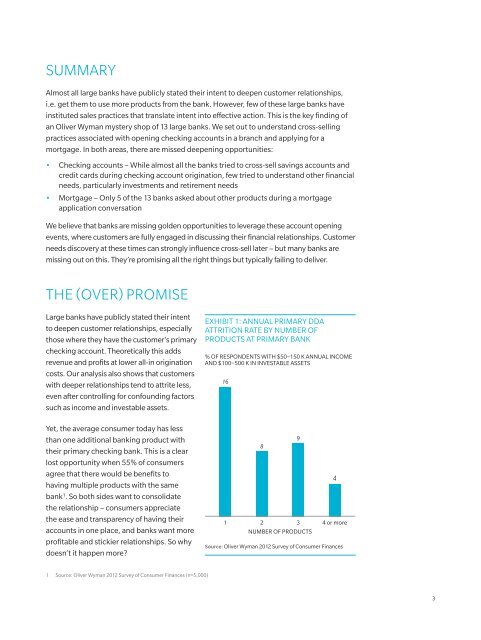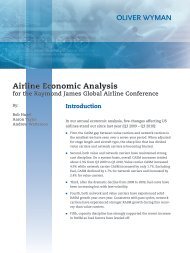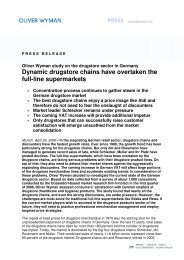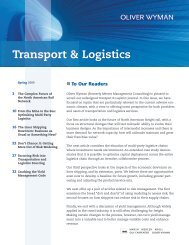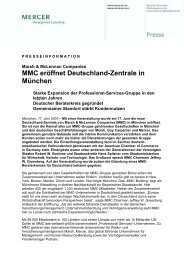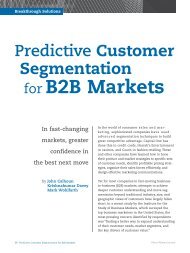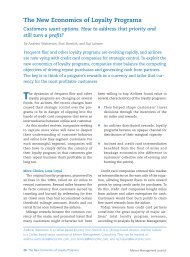Download the Report - Oliver Wyman
Download the Report - Oliver Wyman
Download the Report - Oliver Wyman
Create successful ePaper yourself
Turn your PDF publications into a flip-book with our unique Google optimized e-Paper software.
SUMMARY<br />
Almost all large banks have publicly stated <strong>the</strong>ir intent to deepen customer relationships,<br />
i.e. get <strong>the</strong>m to use more products from <strong>the</strong> bank. However, few of <strong>the</strong>se large banks have<br />
instituted sales practices that translate intent into effective action. This is <strong>the</strong> key finding of<br />
an <strong>Oliver</strong> <strong>Wyman</strong> mystery shop of 13 large banks. We set out to understand cross-selling<br />
practices associated with opening checking accounts in a branch and applying for a<br />
mortgage. In both areas, <strong>the</strong>re are missed deepening opportunities:<br />
••<br />
Checking accounts – While almost all <strong>the</strong> banks tried to cross-sell savings accounts and<br />
credit cards during checking account origination, few tried to understand o<strong>the</strong>r financial<br />
needs, particularly investments and retirement needs<br />
••<br />
Mortgage – Only 5 of <strong>the</strong> 13 banks asked about o<strong>the</strong>r products during a mortgage<br />
application conversation<br />
We believe that banks are missing golden opportunities to leverage <strong>the</strong>se account opening<br />
events, where customers are fully engaged in discussing <strong>the</strong>ir financial relationships. Customer<br />
needs discovery at <strong>the</strong>se times can strongly influence cross-sell later – but many banks are<br />
missing out on this. They’re promising all <strong>the</strong> right things but typically failing to deliver.<br />
THE (OVER) PROMISE<br />
Large banks have publicly stated <strong>the</strong>ir intent<br />
to deepen customer relationships, especially<br />
those where <strong>the</strong>y have <strong>the</strong> customer’s primary<br />
checking account. Theoretically this adds<br />
revenue and profits at lower all-in origination<br />
costs. Our analysis also shows that customers<br />
with deeper relationships tend to attrite less,<br />
even after controlling for confounding factors<br />
such as income and investable assets.<br />
Yet, <strong>the</strong> average consumer today has less<br />
than one additional banking product with<br />
<strong>the</strong>ir primary checking bank. This is a clear<br />
lost opportunity when 55% of consumers<br />
agree that <strong>the</strong>re would be benefits to<br />
having multiple products with <strong>the</strong> same<br />
bank 1 . So both sides want to consolidate<br />
<strong>the</strong> relationship – consumers appreciate<br />
<strong>the</strong> ease and transparency of having <strong>the</strong>ir<br />
accounts in one place, and banks want more<br />
profitable and stickier relationships. So why<br />
doesn’t it happen more?<br />
Exhibit 1: ANNUAL PRIMARY DDA<br />
ATTRITION RATE BY NUMBER OF<br />
PRODUCTS AT PRIMARY BANK<br />
% OF RESPONDENTS WITH $50–150 K ANNUAL INCOME<br />
AND $100–500 K IN INVESTABLE ASSETS<br />
16<br />
1<br />
8<br />
2<br />
3<br />
NUMBER OF PRODUCTS<br />
9<br />
4<br />
4 or more<br />
Source: <strong>Oliver</strong> <strong>Wyman</strong> 2012 Survey of Consumer Finances<br />
1 Source: <strong>Oliver</strong> <strong>Wyman</strong> 2012 Survey of Consumer Finances (n=5,000)<br />
3


